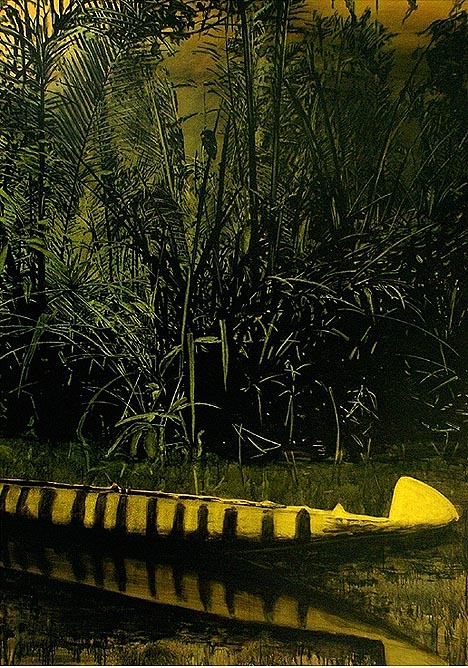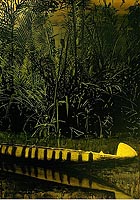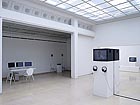
translated and summarized by: Liz Wollner-Grandville,
English summary June 5 - 11
Kunstmuseum Luzern
Stefan à Wengen. The Mission
30.4.10 – 01.08.10
Who is the bad guy?
The title of Stefan à Wengen’s exhibition “The Mission” immediately raises the question on which type of mission could be meant and if this Swiss expat’s first institutional solo exhibition is attempting to do missionary work. His works are hanged alternately and in dialogue with each other and are not separated by different rooms. They depict a limited repertoire of motives: nature scenes with simple architectural constructions such as wooden huts or tree houses in the midst of dense forests as well as animals, roots or water. A large series of portraits is hung in the last room.
We perceive the tree houses through the eyes of a child with a view from below; sanctuaries mounted in between branches. The onlooker’s view drifts through unknown territory; dwellings present themselves as ambivalent places full of silence and unrest, memories and new adventures, inhabited and at the same time deserted. In front of some huts, à Wengen positions symbols of western culture in the form of modernistic sculptures. As if they originated in a different world, they stand in the midst of an archaic landscape and symbolize the path from the artist’s source of inspiration to the work of art.
All paintings are dominated by colour. Gradations of mostly bright colour tones dominate the surface, sometimes in contrast to their complementary colours: an orange-coloured canoe is floating on the blue water in front of purple undergrowth In The Mission XIII (2008) and a raised hide is depicted in front of a purple, yellow, and green setting in Pulpit (2009). On the one hand, à Wengen copies characteristics of photography and on the other hand he intensifies the omnipresent impression of eerie and surreal scenes.
Over and over, he focuses on animal eyes as well as the “evil eye” of humans. In the 49 Ghost Portraits, à Wengen set the eyes of criminals into faces, which were randomly chosen from photo databases. Yet they all don’t have an “evil eye”, but rather an indifferent or even a smiling face.
It is the physiognomy and not the pair of eyes which allows one to draw a conclusion about a person’s character. What is uncanny are the repetitions of the same pairs of eyes in a variety of faces, making us feel uncomfortable about ourselves, because à Wengen’s symbiosis of the apparent good and bad throws us back to the invisible badness within us. It is a lot of fun to be missionized by á Wengen's pictures and to ask: who is the bad guy?
By Marianne Wagner
Kunstmuseum Luzern
6002 Luzern, Europaplatz 1
www.kunstmuseumluzrn.ch
Christine König Galerie
Valentin Ruhry New Port Beach
30.06.2010 – 30.07.2010
Onto the staircase to surf
“Nobody knows where he is heading, if he doesn’t know where he comes from”, the French philosopher Claude Lévi-Strauss once said. In reference to his words, Valentin Ruhry rigged up an exhibition at the Galerie Christine König using diverse natural resources.
New Port Beach is based on the positions of an amateur craftsman and that of an engineer. Which one of the two has, and had, the stronger standing in society? In his combination and differentiated arrangement of assembling the materials, which could be interpreted as a natural resource or as garbage, the roles of an amateur craftsman and that of an engineer are lovingly brought together, proving that the difference can be minimal.
The title of the exhibition is illustrated by a 20 m2 undulating light installation. Yet this “stationary” wave, made of heavy iron profiles and luminous fluorescent tubes, still mediates the feeling conveyed by the sea and the beach; vacation memories captured by snapshots of a New Port Beach sunset on the shores of the Pacific. On the one hand his photo installations remind of Caspar David Friedrich’s landscape paintings, and on the other the continuous interaction of the picture with color gradients reminds of light as an artistic material.
In the second room, the constructive element prevails. U.F.O., a stranded flying object reminds of the amateur craftsman who recycled found material, while Magnet 2, a piece made of plasterboards and sockets makes the engineer visible.
By Alexander Lass
Christine König Galerie
1040 Wien, Schleifmühlgasse 1a
www.christinekoeniggalerie.at
Wendelin Pressl – Revue
Successful theatre with digestion
Vienna is a city in which many things feel at home. One could also say that Vienna is a city with a lively digestion, because in the evenings the traces left behind by the horse carriages are washed from the streets. Many of those who are not in Vienna want to be here.
Nonetheless, Vienna is a city that had to digest a lot, and it is a city in which one could breed black corneal to withstand the hot soot emerging from exhaust pipes even when wearing flip-flops. Too much traffic leads to congestion and flatulence. Squares could actually allow us to have a clear view of the sky, despite the numerous multi-storied houses. But busses, taxis, trucks, motorbikes, and private cars are frequently forced to use underground passages - beneath the sky above these house-free squares. It is admirable that the colour of the sky is still blue when the sun shines. One of those squares, which functioned more like an intestinal loop for traffic than for a walk, was the Fritz-Grünbaum-Platz in Vienna’s Mariahilf district, located between the bomb shelter, the Apollo Cinema and Windmühlgasse near Gumpendorferstrasse. Fritz Grünbaum was a successful comedian, actor and master of ceremonies until the honour of his freedom was taken in 1938 as well as that of a decent funeral; he was murdered in 1941 in Dachau.
Since April 15 a temporary installation has been set up at the Fritz-Grünbaum Platz, forming an integrated stand with stairs and transforming the square into a stage. The difference in levels between the Schadekgasse and the square filled with trees in front of the bomb shelter is doubled up with Wendelin Pressl’s “Revue” and simultaneously levelled out with the upper ranks. The connection between the playful character of revue usually accompanied by music and the looking-back to Fritz Grünbaum’s history appears genuinely sensitive and without any cliché. The staircase is open for everyone and has turned into a public piece of furniture - its character reminding of the first theatres in the first cities. Theater offers the experience of a stage in a magical space, which in turn enables the expansion of awareness.
By Gesche Heumann
Fritz-Grünbaum-Platz 1060 Vienna
Until October 15, 2010
Tiroler Künstlerschaft / Kunstpavillon
Matter of Negotiation
11.06.10 – 24.07.10
Building blocks of a new EUrope
Current and former fellows of the International Fellowship Program for Art and Theory at the Künstlerhaus Büchsenhausen negotiated concepts for a new EUrope.
Not only since the Greek (financial) tragedy and definitely not only on account of this tragedy did new questions arise about the future and the organisation of the EU member states. In this respect, the negotiators rendered valuable memories about turbulent times: memories of Europe’s self-conception as a community of values and culture, of demarcation strategies here, and of attempts to curry a favour there, of social processes respectively regresses, failed revolutions, colonial heritage, nationalism, uniformity, difference. Ana Hoffner, born in former Yugoslavia and living in Vienna since 1989, examines the organisation of queer sexuality in Europe regarding its instrumentalization: she sees it, among others, as a model of legitimizing the colonization of a “backward” and still to be civilized East through an enlightened tolerant West. For curator Andrei Siciodi, Hoffner’s work is the heart of the “Matter of Negotiation” for a new Europe - constituted of intertwining building blocks. And here colonialism meets postcolonial studies. Brigitta Kuster, another Büchsenhausen- fellow, worked on a cinematic expedition into colonial archives focussing on notes made by the German officer Curt von Morgen on his travels to Cameron in 1892 – “A travers le Camerun du sud au nord”. In a whisper - similar to the fading dream of exotic countries - his expedition-report accompanies this semi-documentary search for traces in a colonized room. Longing for a new world? Mona Vatatmanus and Florin Tudor’s work “Il mondo nuovo”, in the style of the same-named fresco by Giandomenico Tiepolo, thwarts this longing by letting the audience glance absentmindedly at a construction site in Innsbruck. Madeleine Bernstorff’s research on the history of the suffragist movement encounters Ina Wudtke’s ironic work about the outsider roles of DJanes - titled “herspace” in reference to the music network “myspace. Dialogues in the new Europe are manifold – they only need to be held.
By Ivona Jelcic
Tiroler Künstlerschaft / Kunstpavillon
6020 Innsbruck, Rennweg 8a
www.kuenstlerschaft.at
Mehr Texte von translated and summarized by: Liz Wollner-Grandville


 Teilen
Teilen





